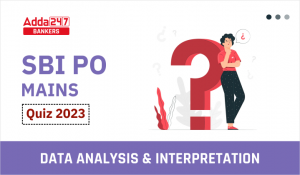Banking Awareness for NABARD Grade-A Exam 2018
Sol. National Payments Corporation of India (NPCI), an umbrella organisation for operating retail payments and settlement systems in India, is an initiative of Reserve Bank of India (RBI) and Indian Banks’ Association (IBA) under the provisions of the Payment and Settlement Systems Act, 2007, for creating a robust Payment & Settlement Infrastructure in India.
Sol. NCMC stands for National Common Mobility Card.
Sol. Considering the utility nature of the objects of NPCI, it has been incorporated as a “Not for Profit” Company under the provisions of Section 25 of Companies Act 1956 (now Section 8 of Companies Act 2013), with an intention to provide infrastructure to the entire Banking system in India for physical as well as electronic payment and settlement systems.
Sol. NPCI stands for National Payments Corporation of India in India.
Sol. NHAI has mandated implementation of the National Electronic Toll Collection (NETC) program for all national highways, which will help reduce the congestion, time is taken to process toll at highways and enable the reduction in revenue leakages.
Sol. National Payments Corporation of India (NPCI), an umbrella organisation for operating retail payments and settlement systems in India, is an initiative of Reserve Bank of India (RBI) and Indian Banks’ Association (IBA) under the provisions of the Payment and Settlement Systems Act, 2007, for creating a robust Payment & Settlement Infrastructure in India.
Sol. The Indian market offers huge potential for cards penetration despite the challenges. RuPay Cards will address the needs of Indian consumers, merchants, and banks. The benefits of RuPay debit card are the flexibility of the product platform, high levels of acceptance and the strength of the RuPay brand-all of which will contribute to an increased product experience.
Lower cost and affordability: Since the transaction processing will happen domestically, it would lead to lower cost of clearing and settlement for each transaction. This will make the transaction cost affordable and will drive usage of cards in the industry.
Customized product offering: RuPay, being a domestic scheme is committed towards the development of customized product and service offerings for Indian consumers.
Protection of information related to Indian consumers: Transaction and customer data related to RuPay card transactions will reside in India.
Provide electronic product options to untapped/unexplored consumer segment: There are under-penetrated/untapped consumers segments in rural areas that do not have access to banking and financial services. Right pricing of RuPay products would make the RuPay cards more economically feasible for banks to offer to their customers. In addition, relevant product variants would ensure that banks can target the hitherto untapped consumer segments.
Inter-operability between payment channels and products: RuPay card is uniquely positioned to offer complete inter-operability between various payments channels and products. NPCI currently offers varied solutions across platforms including ATMs, mobile technology, cheques etc and is extremely well placed in nurturing RuPay cards across these platforms.
Q8. Which of the following is not a Features and Benefits of RuPay Card?
Sol. Features and Benefits of RuPay Card
1. Complimentary Lounge Access Program – Domestic & International
2. 24X7 Concierge Services
3. Earn Cashback time after time
4. Comprehensive Insurance Cover
5. Exclusive Merchant Offers
Sol. NPCI is the country’s only national scheme in retail payment which caters to the domestic market requirements and launches products as per their needs. NPCI’s vision is to bring standardization in technology and processes associated with the payments industry in India. NPCI developed RuPay Contactless specifications are open standards, interoperable and scalable and can be adopted by all card schemes.
S10. Ans.(a)
Sol. Bharat Interface for Money (BHIM) is an app that lets you make simple, easy and quick payment transactions using Unified Payments Interface (UPI). You can make instant bank-to-bank payments and Pay and collect money using the just Mobile number or Virtual Payment Address (UPI ID).
Sol. The following are the features of BHIM:
Send Money: Send money by entering Virtual Payment Address (UPI ID), Account number and QR Scan.
Request Money: Collect money by entering Virtual Payment Address (UPI ID). Additionally through BHIM App, one can also transfer money using Mobile No. (Mobile No should be registered with BHIM or *99# and account should be linked).
Scan & Pay: Pay by scanning the QR code through Scan & Pay or generate your to let others make easy payments to you.
Transactions: Check your transaction history and also pending UPI collect requests (if any) You can raise the complaint about the declined transactions by clicking on report issue in transactions.
Profile: You can view the static QR code and Payment addresses linked to your account. You can also share the QR code through various messenger applications like WhatsApp, Email etc. available on phone and can also download the QR code.
Bank Account: Switch between multiple bank accounts linked with your BHIM App. You can set/change your UPI PIN or check your balance.
Language: Currently BHIM is available in 12 languages, i.e., Hindi, English, Tamil, Telugu, Malayalam, Bengali, Odia, Kannada, Gujarati, Marathi, Assamese and Bengali.
Block User: Block/Spam users who are sending you to collect requests from illicit sources.
Privacy: Allow a user to disable and enable mobilenumber@upi in the profile if a secondary UPI ID is created (QR for the disabled UPI ID is also disabled).
Payment Reminders: Schedule payments as per your convenience.
Split Bill: Splitting bills with multiple UPI users at a click of a button.
Sol. BHIM stands for Bharat Interface for Money.
Sol. Unified Payments Interface (UPI) is a system that powers multiple bank accounts into a single mobile application (of any participating bank), merging several banking features, seamless fund routing & merchant payments into one hood. It also caters to the “Peer to Peer” collect request which can be scheduled and paid as per requirement and convenience.
Sol. The registered office of NPCI is in Mumbai.
S15. Ans.(b)
Sol. Unified Payments Interface (UPI) is a system that powers multiple bank accounts into a single mobile application (of any participating bank), merging several banking features, seamless fund routing & merchant payments into one hood. It also caters to the “Peer to Peer” collect request which can be scheduled and paid as per requirement and convenience.





 Quantitative Aptitude Quiz For SBI PO Ma...
Quantitative Aptitude Quiz For SBI PO Ma...
 Inequalities Basic Reasoning Quiz for Al...
Inequalities Basic Reasoning Quiz for Al...





